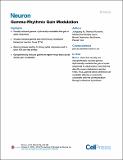| dc.contributor.author | Ni, Jianguang | |
| dc.contributor.author | Wunderle, Thomas | |
| dc.contributor.author | Lewis, Christopher Murphy | |
| dc.contributor.author | Desimone, Robert | |
| dc.contributor.author | Diester, Ilka | |
| dc.contributor.author | Fries, Pascal | |
| dc.date.accessioned | 2017-11-20T18:26:57Z | |
| dc.date.available | 2017-11-20T18:26:57Z | |
| dc.date.issued | 2016-09 | |
| dc.date.submitted | 2016-08 | |
| dc.identifier.issn | 0896-6273 | |
| dc.identifier.issn | 1097-4199 | |
| dc.identifier.uri | http://hdl.handle.net/1721.1/112247 | |
| dc.description.abstract | Cognition requires the dynamic modulation of effective connectivity, i.e., the modulation of the postsynaptic neuronal response to a given input. If postsynaptic neurons are rhythmically active, this might entail rhythmic gain modulation, such that inputs synchronized to phases of high gain benefit from enhanced effective connectivity. We show that visually induced gamma-band activity in awake macaque area V4 rhythmically modulates responses to unpredictable stimulus events. This modulation exceeded a simple additive superposition of a constant response onto ongoing gamma-rhythmic firing, demonstrating the modulation of multiplicative gain. Gamma phases leading to strongest neuronal responses also led to shortest behavioral reaction times, suggesting functional relevance of the effect. Furthermore, we find that constant optogenetic stimulation of anesthetized cat area 21a produces gamma-band activity entailing a similar gain modulation. As the gamma rhythm in area 21a did not spread backward to area 17, this suggests that postsynaptic gamma is sufficient for gain modulation. | en_US |
| dc.publisher | Elsevier/Cell Press | en_US |
| dc.relation.isversionof | http://dx.doi.org/10.1016/J.NEURON.2016.09.003 | en_US |
| dc.rights | Creative Commons Attribution 4.0 International License | en_US |
| dc.rights.uri | http://creativecommons.org/licenses/by/4.0/ | en_US |
| dc.source | Elsevier | en_US |
| dc.title | Gamma-Rhythmic Gain Modulation | en_US |
| dc.type | Article | en_US |
| dc.identifier.citation | Ni, Jianguang et al. “Gamma-Rhythmic Gain Modulation.” Neuron 92, 1 (October 2016): 240–251 © 2016 Elsevier | en_US |
| dc.contributor.department | Massachusetts Institute of Technology. Department of Brain and Cognitive Sciences | en_US |
| dc.contributor.department | McGovern Institute for Brain Research at MIT | en_US |
| dc.contributor.mitauthor | Desimone, Robert | |
| dc.relation.journal | Neuron | en_US |
| dc.eprint.version | Final published version | en_US |
| dc.type.uri | http://purl.org/eprint/type/JournalArticle | en_US |
| eprint.status | http://purl.org/eprint/status/PeerReviewed | en_US |
| dc.date.updated | 2017-11-03T11:57:09Z | |
| dspace.orderedauthors | Ni, Jianguang; Wunderle, Thomas; Lewis, Christopher Murphy; Desimone, Robert; Diester, Ilka; Fries, Pascal | en_US |
| dspace.embargo.terms | N | en_US |
| dc.identifier.orcid | https://orcid.org/0000-0002-5938-4227 | |
| mit.license | PUBLISHER_CC | en_US |
| mit.metadata.status | Complete | |
